Mental healthcare, childcare, and alternative justice could help improve outcomes for Tennessee kids
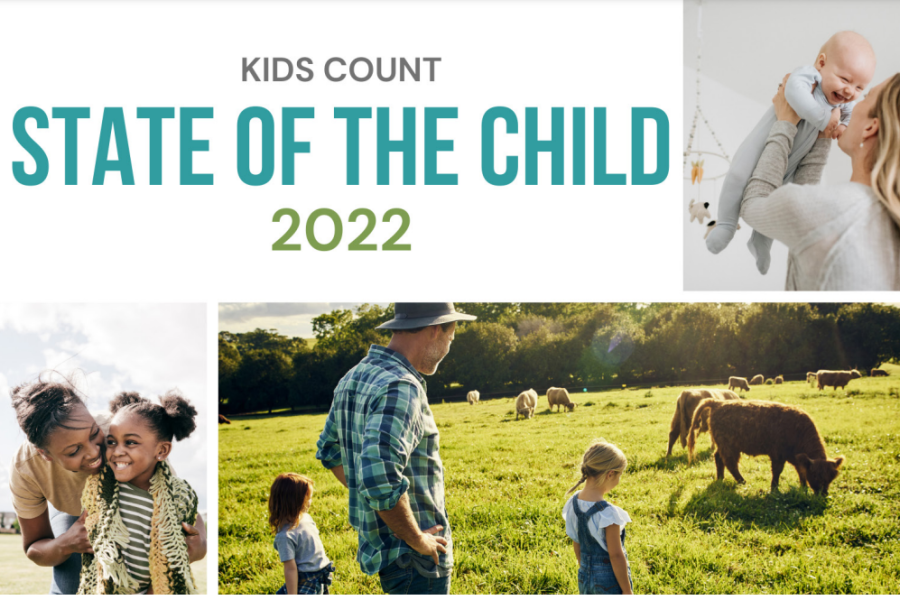
By KATE COIL
TML Communications Specialist
Support services, mental health care, childcare for parents, and alternatives to incarceration are all methods that can better help Tennessee youth have positive outcomes, according to a recent state report.
The 2022 Kids Count: State of the Child report for Tennessee was recently released by the Tennessee Commission on Children and Youth in conjunction with the Anne E. Casey Foundation, showcasing areas where the state is succeeding and needs improvement in matters relating to children, youth, and family.
The report noted that Tennessee’s population has grown more racially diverse with each generation with Generation Alpha (those born after 2010) being more likely to be non-white or mixed race. AN estimated one in eight Tennessee children was born to an immigrant family and one in ten speak a language other than English at home.
Additionally, more than eight in ten Tennessee children attend a public school and live with their biological parents. An estimated one in ten live with their grandparents. Approximately one in 20 have a disability.
ADVERSE EXPERIENCES
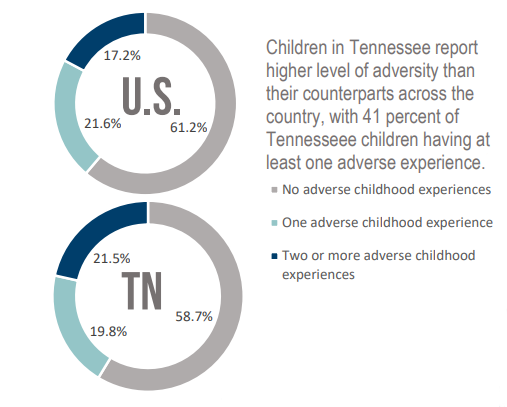 Adverse experiences in childhood (ACEs) are known to have a negative impact on the development of children and into adulthood.
Adverse experiences in childhood (ACEs) are known to have a negative impact on the development of children and into adulthood.
These experiences can come from experiences such as: a divorce, death of a parent or guardian, having an incarcerated parent or guardian, living in a household with someone who is mentally ill, living with someone suffering from addiction, witnessing violence in the neighborhood or home, discrimination based on race or sex, and difficulties in the family providing food and housing. Children in Tennessee report a higher level of adversity than the national average:
- 41% of children having at least one of these negative experiences.
- 21.5% of Tennessee children – more than a fifth – have experienced two of these ACEs
- black children are twice as likely to experience an ACE than their peers.
While children in Tennessee experienced both community and household adversity more than their national peers, Tennessee children were more likely to encounter adverse experiences in the home rather than in the community with one in three children (35%) reporting some sort of household experience. Research showed that children who had an incarcerated parent or guardian were the ones who showed the most negative outcomes.
SUPPORT SERVICES
Numerous support services and infrastructure provided by the community can increase positive outcomes for children. According to the report, neighborhoods with supportive infrastructure for families can play a significant role in not only health and wellness but also future life outcomes.
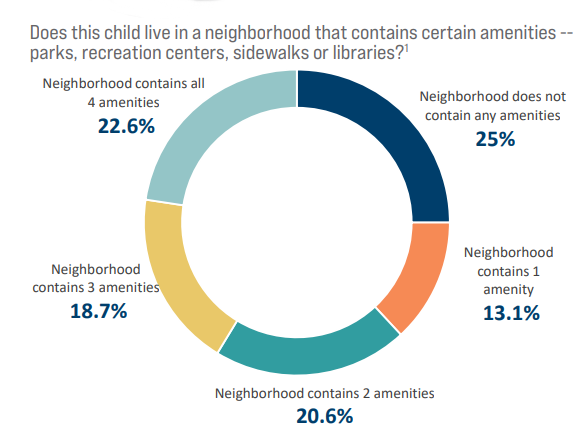 “Positive social connections can support healthy child development while simultaneously acting as a protective factor against toxic stress that can derail development, health and social skills,” the report read. “A child’s environment, particularly access to green space, walkability of neighborhoods and community playgrounds can support healthy behaviors, encourage physical activity, and positively impact children’s cognitive and motor development.”
“Positive social connections can support healthy child development while simultaneously acting as a protective factor against toxic stress that can derail development, health and social skills,” the report read. “A child’s environment, particularly access to green space, walkability of neighborhoods and community playgrounds can support healthy behaviors, encourage physical activity, and positively impact children’s cognitive and motor development.”
The four major amenities for neighborhoods that encourage healthy outcomes are parks, recreation centers, sidewalks, and libraries. A quarter of Tennessee children (25%) live in neighborhoods without any of these amenities while 22.6% live in neighborhoods with all four.
An estimated 60% of Tennessee children live in a “supportive neighborhood,” which is characterized as a neighborhood where neighbors help each other out, watch each other’s children, and know where to go when in need of community services.
Familial support programs – such as family leave, breastfeeding support, and childcare assistance – can also provide long-term positive outcomes for children and families. Only one in five Tennesseans has paid family leave despite employers reporting that paid family and medical leave had no negative impact on productivity, performance, turnover, morale, or profitability.
CHILDCARE
Mothers who take paid family leave are more likely to breastfeed their infants and for longer, which is shown to have a positive impact on infant mortality. Paid family leave also decreases the likelihood of preterm birth, postpartum depression, or reduced food insecurity. Likewise, women who are provided with paid maternity leave are less likely (35%) to require government assistance and 54% more likely to see their earnings increase within a year of the child’s birth.
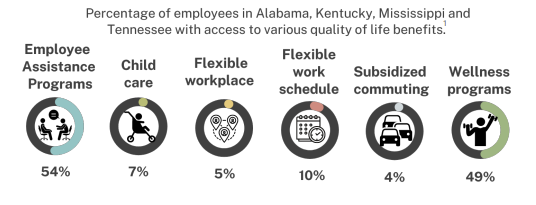
The study found significant benefits to companies who provide evidence-based support practices like company-paid health coverage, paid time off, parental leave, breastfeeding support, onsite-child care, childcare assistance, back-up childcare, flexible hours, and remote work.
The lack of affordable and accessible childcare or early education opportunities is a financial and social stressor for many Tennessee families. It takes, on average, 40.3% of a single-parent's income to afford childcare for an infant.
The cost of center-based care for an infant or four-year-old is 81% higher than the average rent in the state, including:
- $10,780 per year for an infant,
- $9,998 for a toddler,
- $8,759 for a four-year-old, and
- $2,937 per year for a school-age child before and after school.
While affordability is a challenge, most parents (approximately 70%) ranked accessibility to childcare as the biggest challenge. Nearly half (48%) of Tennesseans live in a childcare dessert with access further impacted by the pandemic.
The result is an economic loss to the state with Tennessee seeing $2.6 billion in losses in 2022 due to lack of childcare, 35% of Tennessee parents seeing their pay or hours reduced due to childcare challenges, and 32% of Tennessee parents having to turn down career advancement due to their child care in the past six months.
Tennessee is also behind other states when it comes to government programs that help support families. Tennessee ranks 48th of the states and Washington, D.C. when it comes to how state policy choices positively impact family resources, a formula based on annual minimum wage earnings, out of pocket childcare expenses, and federal and state benefits.
The report founding increase the state-minimum wage, expanded income eligibility for health insurance, paid family leave, and refundable state earned income tax credits could all better help Tennessee support families.
HEALTH RISKS
Tennessee has seen an uptick in maternal mortality rates, despite 90% of pregnancy-related deaths in the state being preventable. The leading cause of pregnancy-related deaths were cardiovascular or coronary conditions while acute overdose was the leading cause of deaths of pregnant women not related to their pregnancy. More than half of pregnancy-related deaths occurred within the first year after birth.

Black women are 2.5 times more likely to die from pregnancy-related issues than white women with discrimination found to be a contributing factor to 1 in 3 pregnancy related deaths. Seven out of 10 women whose deaths were associated with their pregnancy were on TennCare at the time of birth.
Tennessee also ranks 42nd in the nation for infant mortality with 49 out of 51 for infant premature infant births, with one in seven Tennessee infants born prematurely. The state also ranks 38th in adequate prenatal care, 32nd in well-woman visits for maternal care, and 14th cervical cancer screenings.
Many Tennessee children experience significant health risk factors, including
- One in four live in a home where someone smokes,
- 26% have not had a preventative medical visit in the past year, and
- 25% have not received their needed vaccinations by the age of 2, a number in decline since the pandemic.
Additionally, the number of Tennesseans between the age of 10 and 17 who are obese has increased to 22%, making Tennessee the fifth most obese state for this age group.
Parents without healthcare often mean children have no access to childcare as well. Approximately 64% of children who are eligible for coverage in Tennessee also remain uninsured because of the difficulty of accessing and navigating the healthcare system.
“When parents have health insurance, children are more likely to receive the care they need and the preventative care that can avert further health complications and costs,” the report found. “A 12-year study of low-income parent-child pairs found that when the parent was enrolled in Medicaid, the child had a 29%-point higher probability of receiving a well-child visit.”

The report found what while young Tennesseans are generally healthy, many lack access to preventative care that could prevent major health issues down the road.
- An estimated 12% of Tennessee young adults lack health insurance
- one in six report putting off medical care because of the cost.
- One in five reported that they had not participated in any physical activity in the past month.
Young adults were also the most likely to have health risk behaviors, including binge drinking (25.1%), using e-cigarettes (29.3%), and a three-year increase to 28.6% in the amount of young adults diagnosed with mental health issues. The state of Tennessee ranks 41st in youth mental health.
One in four Tennessee children has a mental, emotional, developmental, or behavioral disorder and 71.1% of youth with a major depressive episode received no mental health services. Only 13.7% of students with a major depressive episode report receiving consistent treatment for their issues. One in 11 Tennessee high schools reported attempting to end their own lives and one in five reported “seriously considering” doing so.
An increase in eating disorders in adolescent girls has also been noticed with these disorders having one of the highest mortality rates of any mental disorder. An estimated 97% of those diagnosed with an eating disorder also have a co-condition or secondary disorder they also need treatment for.
Schools are one of the primary ways children receive mental health crisis services or access to mental health support, yet 56% of Tennessee school districts have only one or no psychological professionals on their staff. Half of all mental health conditions begin by age 15 and one in six U.S. school children has a mental health disorder with half going untreated.
“While students attend school primarily to obtain an education, the need for social, emotional and physical support services at schools cannot be overstated,” the report said. “Aside from their homes, children spend more time at school than anywhere else. Behavioral, emotional or physical health conditions are often first identified in schools.”
Substance abuse among Tennessee students has remained fairly consistent, though has been impacted by the pandemic. Around 15% of students said they drank more alcohol during the pandemic than they did before while 12% said they used drugs more frequently during the pandemic than before.
However, the overall rates of use of cannabis, nicotine, and alcohol decreased during the pandemic for most students. E-vapor products remain the most common substance consumed by Tennessee teens with 4.8% reporting to be daily smokers and 36.1% saying they have tried it at least once.
POVERTY
Contributing to issues like food insecurity and housing, poverty among young Tennesseans can often set the stage for poor performance and behavior in school. Tennessee has seen a historic five-year decline in child poverty with the state reporting 18.1% overall child poverty and 18.9% in poverty for children under five. In the past decade, 100% of Tennessee counties have seen a decline in child poverty with 32% seeing a decline in the past year.
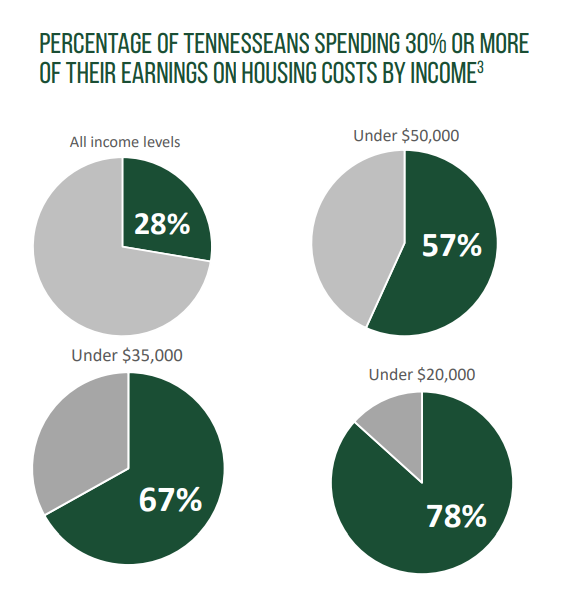
“This is encouraging due to the historical tendency for [children under five] to experience the highest rates of poverty,” the report stated. “Further, the rapid amount of brain development occurring in the first five years that can be negatively impacted by experiencing poverty.”
Children who face economic struggles often become adults who have financial issues. Young adults are also facing issues as they try to enter the job market, such as:
- One in five are living below the federal poverty line
- 42% making less than $27,180 per year.
- Half of young adult Tennesseans are living on their own rather than with parents or other family.
Housing is one of the biggest financial struggles for Tennesseans: more than one in four Tennesseans and more than one in three low-income families facing cost-burdens for housing. Research has shown households with high housing cost-burdens are less likely to have enough resources for other necessities such as food, clothing, and medical expenses.
One in four Tennessee households with children had little or no confidence in their ability to make their next housing payment and 41% live in a house built prior to 1979, making lead exposure and associated health risks more likely.
While homelessness among Tennessee students has decreased, more Tennessee children are sleeping in less safe environments. There has been a slight increase in the number of Tennessee public school students who sleep in cars, parks, campgrounds, temporary campers, and abandoned buildings in the past year (3.1%). Children experiencing homelessness have three times the rate of emotional and behavioral issues of their peers.
Nearly one in five Tennessee children experience food insecurity in Tennessee with 23% of Tennessee households with children reporting they didn’t have enough to eat in the previous week. During that same time frame, 53% said they had difficulty paying for usual expenses. On the national level, those in the lowest income brackets are likely to spend a fourth of their income just on food.
WELFARE AND CRIMINAL JUSTICE
Traumatic childhood events such as abuse and neglect can have negative impacts on the rest of a child’s life. In 2022, the state of Tennessee substantiated 5,415 cases of abuse or neglect, a major decline since numbers peaked in 2015. Approximately 3.5 per 1,000 reported cases of child abuse or neglect are substantiated. Of those children taken into custody, one in ten are in foster care for more than two years. One in five children entering foster care will reenter state care and one in eight will reenter care in less than a year.
Tennessee struggles with foster care instability at a much higher rate than the rest of the country. Approximately 33.7% of Tennessee children experience foster care instability, higher than the national average of 14.9%.
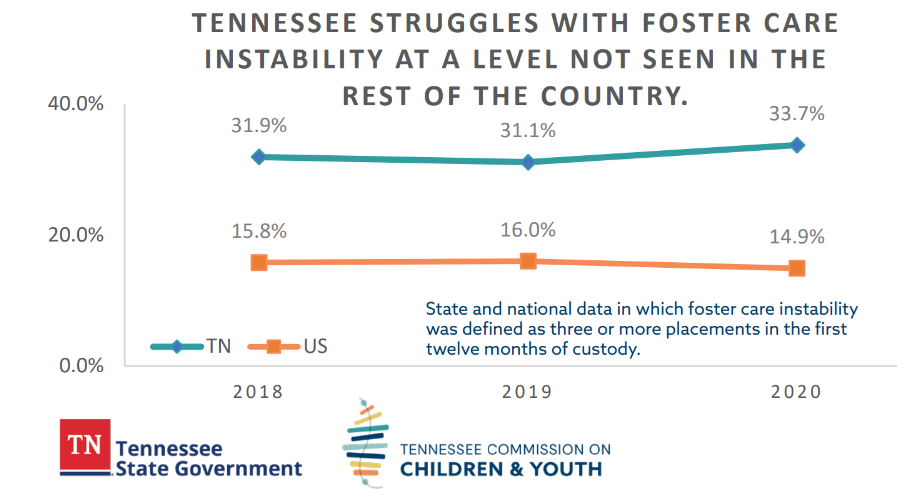
One in five children in foster care are aged 16 or older. The fact that Tennessee provides support for those who age out of foster care through services like wrap-around services, life skills classes, and educational vouchers has a positive impact on the Tennesseans who choose to take advantage of these services. The acceptance of this extended care has increased steadily since its inception, making recipients less likely to experience homelessness, unemployment, and have completed post-secondary education.
More than one in ten Tennessee children are victims of domestic violence situations with 29% of the state’s domestic violence victims being aged 24 or younger. More than one in six Tennessee high school girls reported experiencing data violence, nearly twice the national rate.
Human trafficking reports related to children remained steady throughout the pandemic with 42% of children being trafficked by a family member. A rise in recruitment on social media platforms was reported during this period with most victims either being recruited by family members or intimate partners. The top risk factors for sex trafficking were substance abuse, homelessness, unstable housing, mental health issues, or a recent migration or move.
Tennessee has seen a decline in suspensions and expulsions of students since 2019 with alternative discipline methods allowing students to remain educationally engaged. This allows students to have more positive outcomes as suspended and expelled students are 10 times more likely to drop out of school due to falling behind. Alternatives to youth jail, such as transition homes and youth development centers, also help youth in the justice system see better outcomes and avoid transitioning into the adult justice system.

